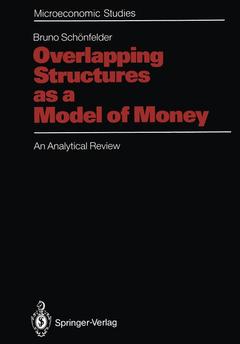1. Introduction.- 1.1. The “Integration of Monetary and Value Theory”.- 1.2. The Concept of an “Overlapping Structure”.- 1.3. The Purpose of this Book.- 2. The Overlapping Generation Model: An Overview.- 2.1. The Samuelson-Model.- 2.1.1. The Physical Set-up, Pseudo-Laissez faire, “Bubbles”, and Ponzi-Schemes.- 2.1.2. Three Equilibrium Concepts.- 2.1.3. Perfect Foresight Equilibrium.- 2.1.4. Repudiation of Paper Money.- 2.1.5. Stochastic Rational Expectations Equilibrium I.- 2.1.6. A Digression: Historical Instances of Repudiation.- 2.1.7. Stochastic Rational Expectation Equilibrium II.- 2.1.8. Stochastic Rational Expectation Equilibrium III.- 2.1.9. Temporary Equilibrium.- 2.1.10. Learning a Rational Expectation Equilibrium.- 2.2. OGMs with Production and Capital.- 2.2.1. The Diamond-Tirole Model.- 2.2.2. A Diamond-Model with Spatial Separation.- 2.2.3. The Indetermincay of Equilibrium in the Diamond-Tirole-Model.- 2.2.4. Deterministic Cycles.- 2.3. Generalizations of the Basic Model.- 2.3.1. Models with a Variable Quantity of Money.- 2.3.2. Enlargement of the Commodity Space and Lengthening the Live Spans of Agents Beyond Two Periods.- 2.3.3. Bequests.- 2.3.4. Stochastic Versions of the OGM.- 2.4. The Interpretation of Indeterminacy.- 2.4.1. Selection Criterions.- 2.4.2. A Strategy of Neglect.- 2.4.3. Do Multiple Equilibria Indicate the Incompleteness of the Theory?.- 2.4.4. Indeterminacy as Instability.- 2.4.5. Indeterminacy as Neutrality of “Stability”.- 2.4.6. Is Indeterminacy a Reason to Dismiss the Model?.- 2.5. Concluding Remark.- 3. Overlapping Structures and Cash-In-Advance Constraints.- 3.1. Cass’ Theorems.- 3.2. The Analogy between the Samuelson Model and a Simple Cash-in-Advance Constraint Model.- 3.3. A Physical Structure which Generates Cash-in-Advance Constraints.- 4. The Rate of Return Paradox I: OGM with Transaction Costs.- 4.1. A Transaction Costs Model by Bryant and Wallace.- 4.2. Difficulties of Identifying Safe Assets and the Rate of Return Paradox.- 4.3. Baumol’s Inventory Model of Money.- 4.4. A Concluding Remark.- 5. The Rate of Return Paradox II: “Legal Restrictions”.- 5.1. “Legal Restrictions” in the FR Germany.- 5.2. Implications of the Legal Restriction Theory.- 5.3. Some Observations from Monetary History and the Present.- 5.3.1. The Bons de la Defence Nationale.- 5.3.2. Interest on Checkable Deposits: The American Example.- 5.3.3. Rate of Return Differentials and Laissez Faire Banking.- 5.3.4. Summary.- 5.4. Legal restrictions as an Expedient for Levying the Inflation Tax.- 5.5. Minimum Reserve Requirements and Indeterminacy.- 5.5.1. Tirole’s Analysis.- 5.5.2. Interest on (Minimum) Reserves.- 5.5.3. The Svensson and Englund-Model.- 5.6. Minimum Sizes for Privately Issued Bearer’s Notes.- 5.7. Holding out the Prospect of Backing.- 5.8. Concluding Remark.- 6. Private Production of Outside Money.- 6.1. Competition between Private Producers of Fiat Money.- 6.2. Money as a Natural Monopoly.- 6.3. Gresham’s Law.- 6.4. Concluding Remark.- 7. Topics in Commodity Money Theory.- 7.1. A Model of a Gold Specie Standard.- 7.1.1. The Physical Environment and Equilibrium.- 7.1.2. Two Cash-in-advance Constraint Models.- 7.1.3. Inefficiency of Commodity Money.- 7.2. The Quantity Theory of Money.- 7.3. Uniqueness of Equilibrium.- 7.3.1. Some Generalizations of the Model.- 7.3.2. Parallel Currency.- 7.3.3. Gresham’s “Law”.- 7.3.4. Symmetallism and Graham-Plan.- 7.4. Restrictions on the Production of Inside Money.- 7.4.1. Scottish Banking Revisited.- 7.5. Commodity Money without Reserves.- 8. A Few Macroeconomic Applications.- 8.1. A Model with Non-Interest Bearing Money and Interest-Bearing Public Debt.- 8.2. “Backed” and “Unbacked” Public Debt.- 8.3. A Simple Model with Cash-in-advance Constraints and Credit Goods.- 8.4. The Distinction between Outside and Inside Money.- 8.5. The Fisher Effect.- 8.6. Grandmont-Policy.- 9. Monetary Policy in The Open Economy.- 9.1. The Kareken and Wallace Model.- 9.1.1. The robustness of Kareken’s and Wallace’s Results.- 9.1.2. Preference for Domestic Currency and Sticky Prices.- 9.1.3. Uncertain Change of Regime.- 9.1.4. Minimum Reserve Requirements and Other Legal Restrictions.- 9.2. Stabilizing and Destabilizing Speculation.- 9.2.1. Speculation and Intrinsic Uncertainty.- 9.2.2. A Model with Extrinsic Uncertainty.- 9.3. Concluding Remark.- 10. Summary and Conclusions.- 10.1. Summary.- 10.2. Conclusions.




